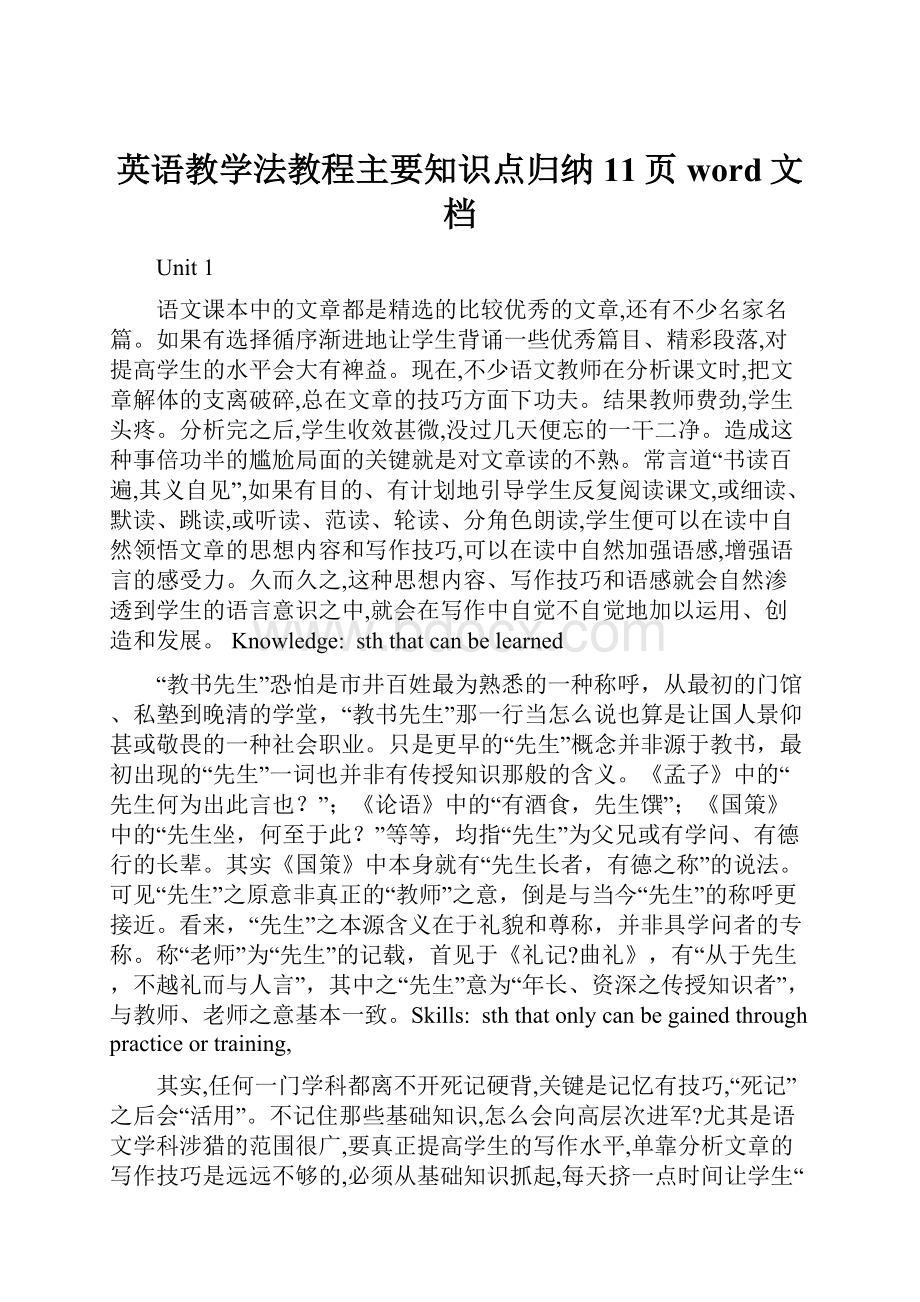英语教学法教程主要知识点归纳11页word文档.docx
《英语教学法教程主要知识点归纳11页word文档.docx》由会员分享,可在线阅读,更多相关《英语教学法教程主要知识点归纳11页word文档.docx(20页珍藏版)》请在冰豆网上搜索。

英语教学法教程主要知识点归纳11页word文档
Unit1
语文课本中的文章都是精选的比较优秀的文章,还有不少名家名篇。
如果有选择循序渐进地让学生背诵一些优秀篇目、精彩段落,对提高学生的水平会大有裨益。
现在,不少语文教师在分析课文时,把文章解体的支离破碎,总在文章的技巧方面下功夫。
结果教师费劲,学生头疼。
分析完之后,学生收效甚微,没过几天便忘的一干二净。
造成这种事倍功半的尴尬局面的关键就是对文章读的不熟。
常言道“书读百遍,其义自见”,如果有目的、有计划地引导学生反复阅读课文,或细读、默读、跳读,或听读、范读、轮读、分角色朗读,学生便可以在读中自然领悟文章的思想内容和写作技巧,可以在读中自然加强语感,增强语言的感受力。
久而久之,这种思想内容、写作技巧和语感就会自然渗透到学生的语言意识之中,就会在写作中自觉不自觉地加以运用、创造和发展。
Knowledge:
sththatcanbelearned
“教书先生”恐怕是市井百姓最为熟悉的一种称呼,从最初的门馆、私塾到晚清的学堂,“教书先生”那一行当怎么说也算是让国人景仰甚或敬畏的一种社会职业。
只是更早的“先生”概念并非源于教书,最初出现的“先生”一词也并非有传授知识那般的含义。
《孟子》中的“先生何为出此言也?
”;《论语》中的“有酒食,先生馔”;《国策》中的“先生坐,何至于此?
”等等,均指“先生”为父兄或有学问、有德行的长辈。
其实《国策》中本身就有“先生长者,有德之称”的说法。
可见“先生”之原意非真正的“教师”之意,倒是与当今“先生”的称呼更接近。
看来,“先生”之本源含义在于礼貌和尊称,并非具学问者的专称。
称“老师”为“先生”的记载,首见于《礼记?
曲礼》,有“从于先生,不越礼而与人言”,其中之“先生”意为“年长、资深之传授知识者”,与教师、老师之意基本一致。
Skills:
sththatonlycanbegainedthroughpracticeortraining,
其实,任何一门学科都离不开死记硬背,关键是记忆有技巧,“死记”之后会“活用”。
不记住那些基础知识,怎么会向高层次进军?
尤其是语文学科涉猎的范围很广,要真正提高学生的写作水平,单靠分析文章的写作技巧是远远不够的,必须从基础知识抓起,每天挤一点时间让学生“死记”名篇佳句、名言警句,以及丰富的词语、新颖的材料等。
这样,就会在有限的时间、空间里给学生的脑海里注入无限的内容。
日积月累,积少成多,从而收到水滴石穿,绳锯木断的功效。
Languageskills:
listening,speaking,readingandwriting
Languageisasystemofarbitraryvocalsymbolsusedforhumancommunication。
Viewsonlanguage:
1、Structuralview(languagecompetence)
—Thefounder:
Saussure
—Thestructuralviewoflanguageseeslanguageasalinguisticsystemmadeupofvarioussubsystems:
1、thesoundsystem(phonology)2、soundcombinations(morphology)3、meaningforcommunication(syntax)
—Learningthelanguageistolearnthestructuralitems,studytheinnerstructureandruleoflanguage,ignorethesocialfunctionsofthelanguage。
2、Functionalview
—Representative:
Johnson、marrow、swaincanal(thecore:
grammar)
—Thefunctionviewnotonlyseeslanguageasalinguisticsystembutalsoameansfordoingthings
—Learnerslearnalanguageinordertobeabletodoingthingswithit
Usethelinguisticstructuretoexpressfunctions
3、Interactionalview(communicativecompetence)
—Emphasis:
appropriateness
—Languageisacommunicativetool,whichmainuseistobuildupandmaintainsocialrelationsbetweenpeople
—Learnersneedtoknowtherulesforusingthelanguageincertaincontext
—Thestructuralviewlimitsknowingalanguagetoknowingitsstructuralrulesandvocabulary
Languageteacherqualifications:
1、agoodcommandofspokenandwrittenlanguage
2、formulatetheorypresupposition
3、languagebackgroundandexperience
4、knowhowlanguagesarelearnt
5、theabilitytousemethodsinvarioussituations
6、deepunderstandingofculturalbackground
7、understandingtheprinciplesofteaching
Theseelementscanbecategorizedintothreegroups:
ethicdevotion,professionalqualitiesandpersonalstyles
Viewonlanguagelearning
1.Psycholinguistic:
therelationshipbetweenlanguageandthinking.
1)Thinkinginlanguage
2)Languageisnecessaryforthought.
3)Languageacquisition(语言习得)
4)Learnersintheirearlieryearsacquirecontroloveressentialstructureoftheirlanguagewithoutspecialteachingandlearninginaeffortlessandalmostanunconsciousway(liketheformationofahabit)peoplepreferfirstlanguageacquisitiontofirstlanguagelearning.
2.Cognitivetheory:
theruleforpeopletoawaretocognizesth.
Cognitiveprocesses:
Process:
input----absorb----output
Languagelearningisnotjuststimulate-reflection,buttheusingofoursubjectivecapabilities,theusingofourcognitiveabilitytothinkthelanguageandstudyingitactively.
3.Constructivisttheory:
learningisaprocessofmeaningconstructionbasedonlearner’sownknowledgeandexperience.
S----------AT------------R
(刺激)(反应)
Stimulus:
assimilation①andaccommodation②
1把外部知识纳入自身
2纳入自身后也不相符,就要对原有知识进行改变,也就是一种原有知道和外部知识保持联系的创新的过程。
Unit2
1.CLT(交际英语教学):
itisanapproachthatconsidersthefunctionalandsocialfactorsinlanguage,emphasizesthattheaimoflanguageteachingistohelpthelearnersacquirecommunicativeability.Itoffersaneffectivewaytolearnlanguagethroughlanguageuse.
Thebasis:
thetheoryofsociologyandsociolinguistic.
2.Languagehastwofunctions:
A.thetransactionalfunction→toexpressthecontextB.theinteractional(相互影响的)function→toshowsocialrelationsandpersonalattitude
Languageisusedtoperformcertaincommunicationfunctions;useallskills:
A.Receptiveskill:
listeningandreadingB.Productiveskill:
speakingandwriting;usedinacertainsocialcontext:
teachthepartoflanguageinrealliferatherthanallthelanguagestudentsdevelopallthelanguageskills.
3.Traditionalpedagogy(传统教学法):
focusontheformsoflanguage.
4.TraditionalclassVS.CLT
Listening:
totheteacher,tothetape→sth.unpredictable,sth.authentic,sth.meaningful
Reading:
learninglanguage→getinformation,exactmeaning,differentskills
Speaking:
repeating,answering,retelling→sth.creating,expressoneself
Writing:
composition,translation→writetoexpressoneself,one’sfeeling,one’sthought;writewhatpeoplewriteinthewaypeoplewrite.
5.LinguisticCompetence(=languagecom.)
Chomsky:
tacitknowledgeoflanguagestructuresandtheabilitytousetheknowledgetounderstandandproducelanguage.
6.CommunicativeCompetence
Bothknowledgeaboutthelanguageandtheknowledgeabouthowtousethelanguageincommunicativesituationappropriately.
7.FeaturesofCLT:
1.focusondevelopingcommunicativecompetence
2.Focusonusefulandnecessarylanguage
3.Payattentiontothecommunicativetask
4.Placeimportanceonstudents'beingfluent
5.Encouragestudentstotakepartinactivities
6.Understandthestudentsareofdifferentstand
7.AwarethatthereisnotjustonekindofEnglish
8.MeritsofCLT:
1.likelytogivethestudentsallskills
2.Morerelevant
3.Lesswasteoftimeandeffort
9.DemeritofCLT:
1.makegreatdemandsupontheprofessionaltrainingandskillsoftheteacher
2.Difficulttocheekwhatstudenthaveleart
3.Don'toffertheteacherthesecurityofthetextbook
Unit4
1.Whatisteaching?
Teachingmeansensuringthatthestudentshavelearntormasteredwhatisbeingtaughtthroughapropersequenceofsteps,sotheteachershouldcarefullypreparethelessons,arrangethesteps,madefulluseofeverysecondinclass.
2.Principlesforgoodlessonplanning
A.AimB.VarietyC.FlexibilityD.learningabilityE.linkage
3.Macroplanninginvolvesthefollowing:
A.theanalysisoftheschool
B.theanalysisofthestudents(information,background)
C.theanalysisofthesyllables(教学大纲).(principle,purpose,requirement)
D.theanalysisofthetextbook(教材分析)
E.theteachingmethodsandreform(教学方法及其改革)
F.theteachingobjectiveandarrangement(整体教学目标及安排)
4.Componentsofalessonplan:
A.Backgroundinformation
BTeachingaims
C.Languagecontentsandskills
D.stagesandprocedures
E.Teachingaids
F.Endoflessonsummary
G..Optionalactivitiesandassignments
H.Afterlessonreflection
5.Howtomakeamicroplan.
A.Theteachingaimsanddemands(ability,knowledge)
B.Theteachingcontents
a.vocabulary,phrase
b.structure
c.grammar
d.skills
C.Theteachingimportantanddifficultpoints
D.Theteachingmethodsandaims
E.Theteachingprocedure
a.stage1:
warm-upactivities
b.stage2:
(step1:
presentation-------step2:
pratice-------step3:
production)
c.stage3:
lessonsummary
d.stage4:
assignments/optionalactivities
e.stage5:
afterclassreflection
Unit5
Ⅰ.Theroleoftheteacher(basedonthefunctionoftheteacher):
1.Controller:
controlthepace,thetime,thetargetlanguage,thestudent.
2.Assessor:
twothings
a.ascorrector:
correctthemistakes,organizingfeedbackthelearners
b.asevaluator:
tocreateasuccess-orientedlearning,atmosphere,morepraise,lesscriticism
3.Organizer:
taskbasedonteachingtodesigntasksandtoorganize
4.Prompter:
togiveappropriatepromptshints
5.Participant:
totakepartintheactivities
6.Resource-provide:
asawalkingdictionary
Ⅱ.Rulesformakinginstructionseffective:
1.simple2.natural3.targetlanguage/bodylanguage
4.givetimetogetusedtolisteningtoEnglish
5.Modelthetasks/activitiesbeforedoingthemclearinstructions
Ⅲ.Thecommonstudentgroupingsare:
a.wholeclasswork;b.pairwork;c.groupwork;d.individualstudy
Ⅳ.Disciplinereferstoacodeofconductwhichbindsateacherandagroupofstudentstogethersothatlearningcanbemoreeffective
哪些因素影响学生纪律:
1.teacher’sbehavior
a.choiceofmethodology
b.teacher’spreparationforthelearners
c.interpersonalrelationshipwiththelearners
2.motivation/purpose/desire/surrounding
Ⅴ.Howtomaintainthediscipline:
1.createacodeofbehavior
2.beconsistentinapplyingtherules
3.befriendlyandtalktostudents
4.immediatelyaction
5.befairtoeveryonedealwithproblemsimpersonally
Ⅵ.Measuresforindisciplinedactsandbadlybehavingstudents:
(P81)
1.actimmediately
2.stoptheclass
3.rearrangetheseats
4.changetheactivities
5.talktostudentsafterclass
6.createacodeofbahaviour
Ⅶ.Adviceaboutproblemsonclass:
(P81)
1.dealwithitquietly
2.don’ttakethingspersonally
3.don’tusethreats
Ⅷ.Questionintheclass
Purpose:
1.tofocusonthestudents’attention;
2.toinvitethinkingandimagination;tochecktheunderstanding;
3.tosimulatethestudentstorecallinformation;
4.tochallengestudents;
5.toassesslearning
Typesofquestion(P83)
1.closequestion-onlyoneanswer
2.openquestion-manydifferentanswer
Ⅸ.Dealingwitherrors
1.Mistake-----withnothingtodowithlanguagecompetence(causedbycarelessness→self-correction)
2.Error-----hassthtodowiththelanguagecompetence(causedbylackingofknowledge→bedealtwiththehelpoftheteacherandotherclassm